The Heightened ‘Security Zone’ Function of Gated Communities during the COVID-19 Pandemic and the Changing Housing Market Dynamic: Evidence from Beijing, China
Abstract
:1. Introduction
2. Gated Communities in China and the Impact on Housing Market Dynamics
3. Data and Methodology
3.1. The Case Study of Beijing
3.2. Data Collection
3.2.1. Online Household Survey
3.2.2. Housing Transaction Data
3.3. Methods for Data Analysis
4. Changing Perception of GCs
5. Housing Market Dynamics Affected by the Changing Perception of GCs
5.1. Housing Price Premium
5.2. Number of Visited Applicants and Discount from Listing Prices
6. Conclusions and Discussion
Author Contributions
Funding
Data Availability Statement
Acknowledgments
Conflicts of Interest
Appendix A
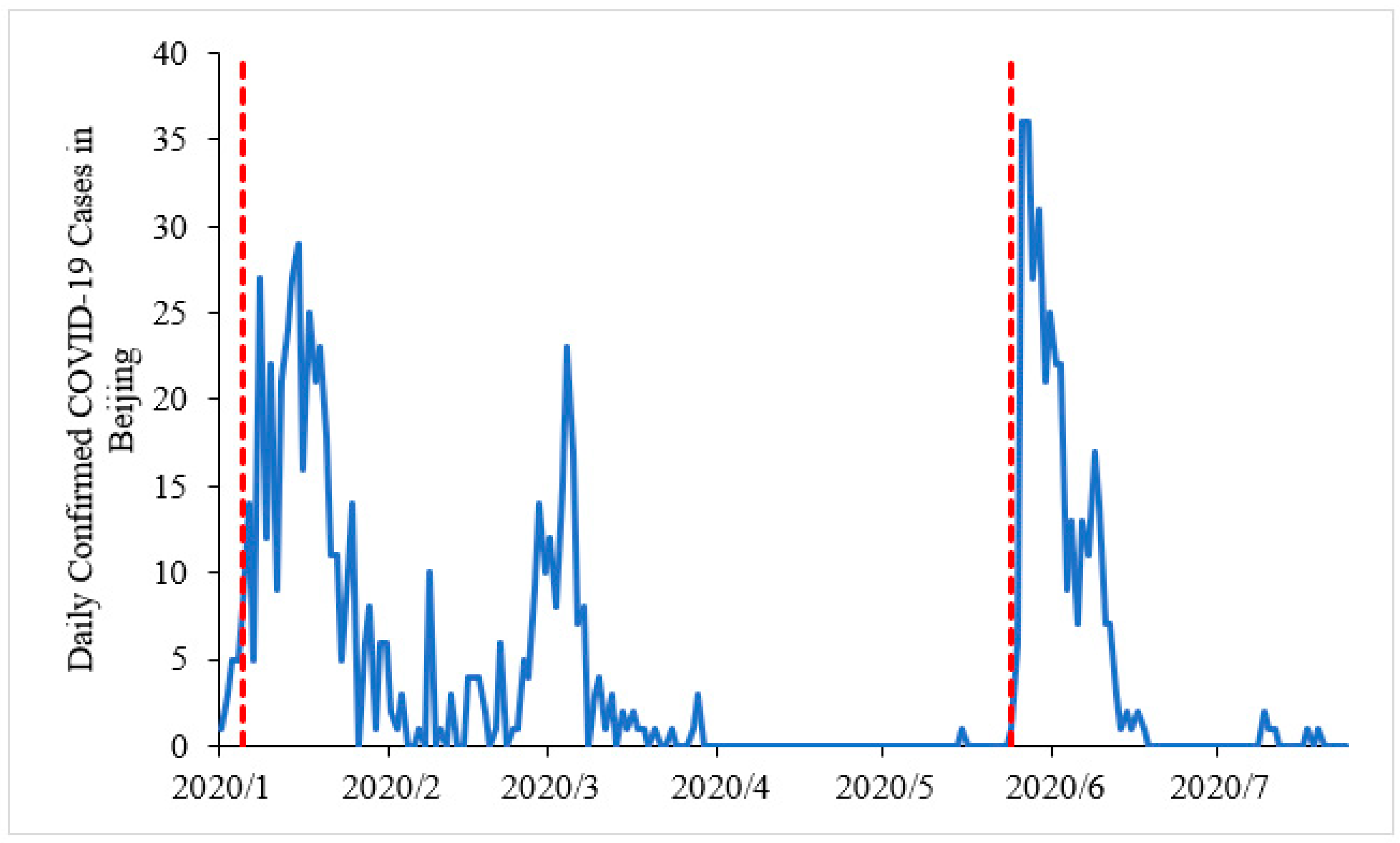
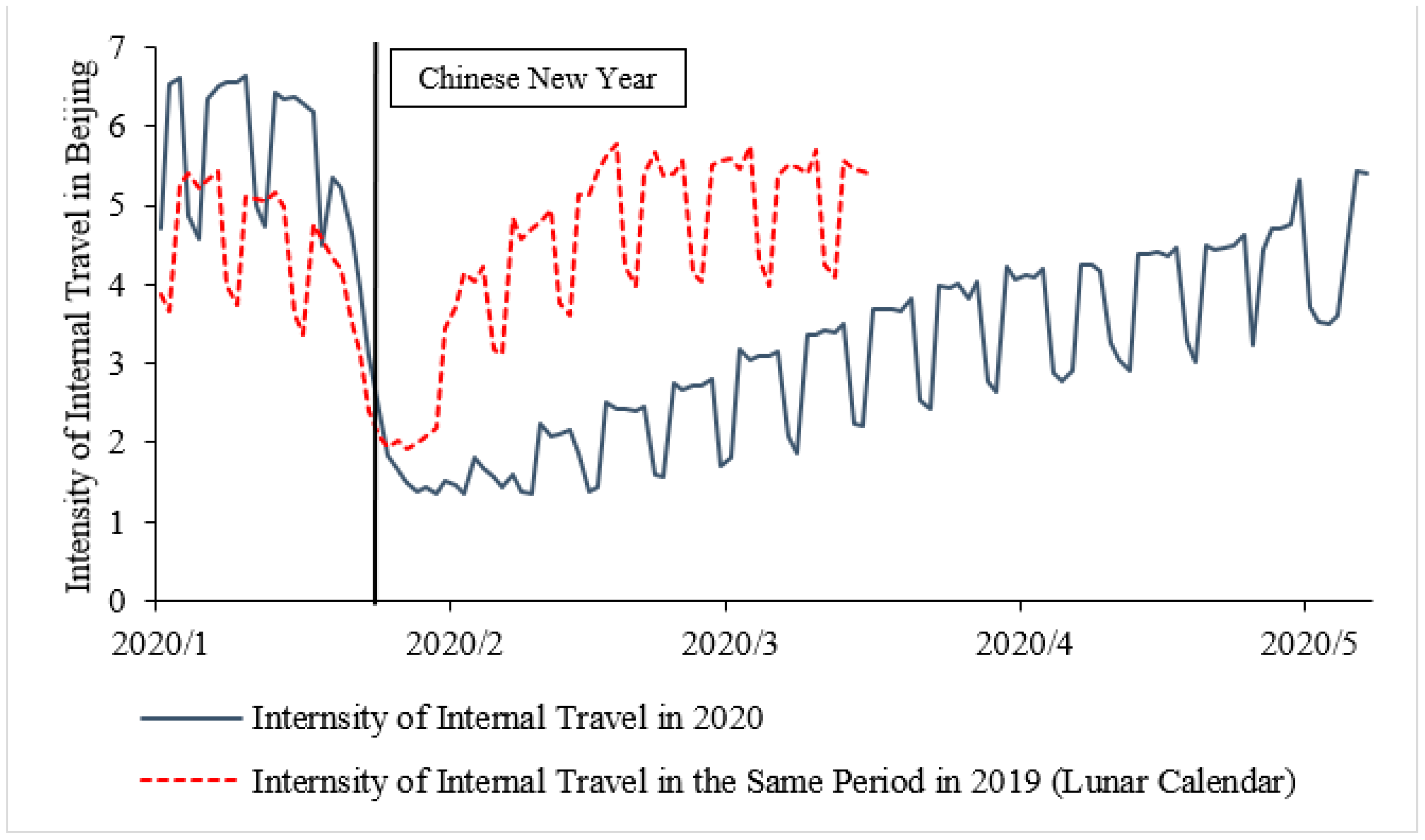
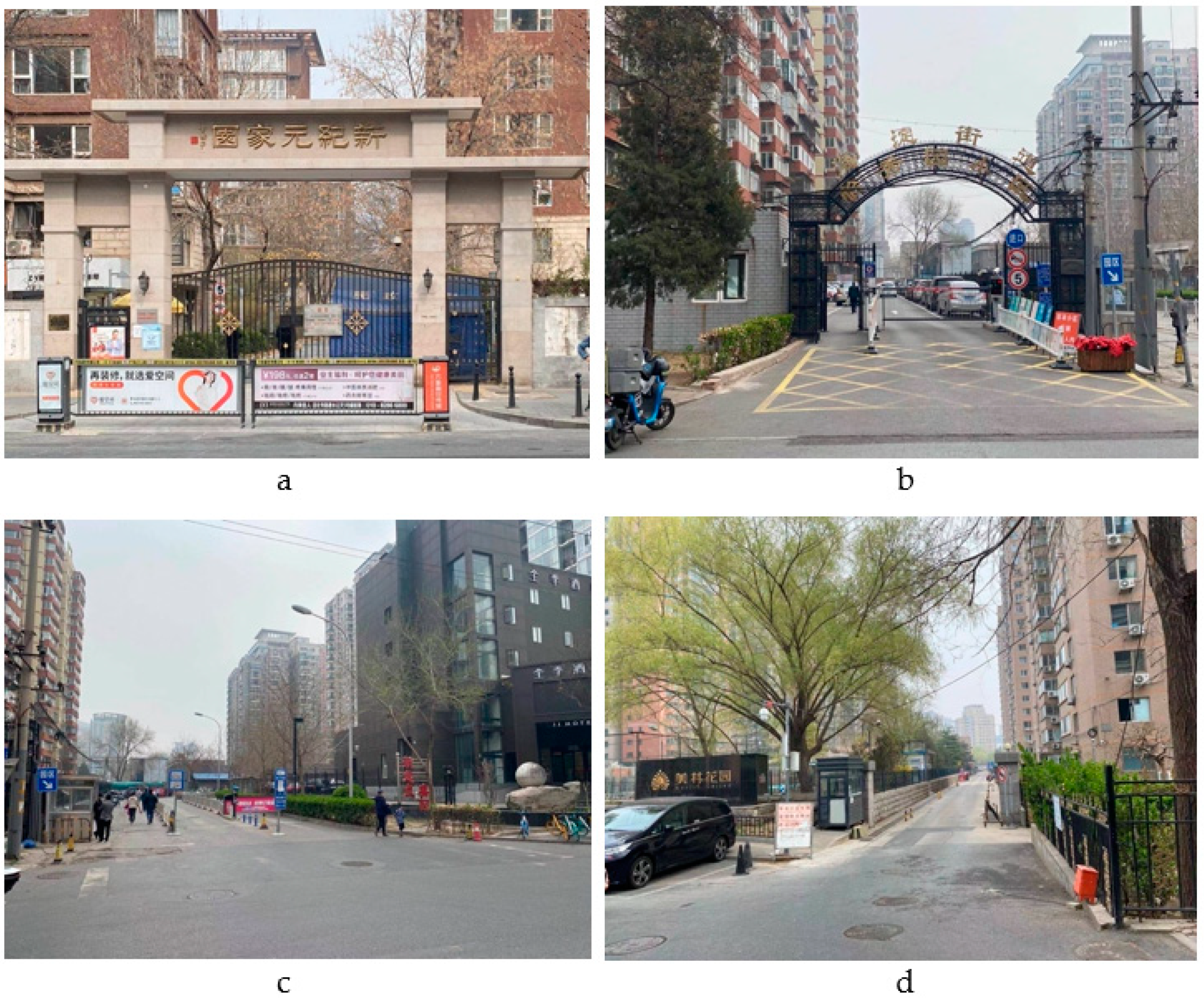
Appendix B
Q1: Does your residential community have the following gated facilities?
|
Q2: Does your residential community require “entrance permit” during the pandemic?
|
Q3: Do you think the following community access control measures are useful for preventing and controlling the pandemic?
|
Q4: Do you agree the following argument: (using 5-point Likert scale)
|
Q5: Are you willing to pay more for living in a gated community than in an open community, holding other factors constant?
|
| Variables | Definition |
|---|---|
| Price | The transaction price of the property in the unit of million RMB. |
| Gated | A dummy variable equal to 1 if all the pedestrian entrances are visible from the map and are with access controls, zero otherwise. |
| Gated Robust | A dummy variable equal to 1 if all the visible pedestrian entrances from the map are with access controls, although some entrances do not have street views which inhibits the identification of the access control. Otherwise, it equals zero. |
| Gated Degree | A continuous variable equal to 3 if all the pedestrian entrances are visible from the map and are with access controls, and 2 if all the visible pedestrian entrances from the map are with access controls, although some entrances do not have street views. Otherwise, it equals one. |
| Estate Area | The estate’s total floor area in the unit of thousand squared meters. |
| Visited Applicants | Total number of visited applicants (i.e., potential buyers) between listing and final transaction. |
| Discount from Listing Price | The discount in the final transaction price from the listing price, calculated as 1–(transaction price/listing price). |
| High Green Ratio | A dummy variable equal to 1 if the green ratio of the estate is larger than 20%, zero otherwise. |
| High Plot Ratio | A dummy variable equal to 1 if the plot ratio of the estate is larger than 3, zero otherwise. |
| Luxury Estate | A dummy variable equal to 1 if the average unit size in an estate is in the top 10% of the average unit size of all estates in Beijing, zero otherwise. |
| With Lift | A dummy variable equal to 1 if the building has a lift, zero otherwise. |
| Post COVID 1 | A dummy variable equal to 1 if the transaction is after 22 January 2020 (i.e., the lockdown of Wuhan) and before 11 June 2020 (i.e., the outbreak in the Xinfadi Seafood Market), zero otherwise. |
| Post COVID 2 | A dummy variable equal to 1 if the transaction is after 11 June 2020 (i.e., the outbreak in the Xinfadi Seafood Market), zero otherwise. |
| Gross Floor Area | Total gross floor area of the unit. |
| No. of Bedrooms | Number of bedrooms in the unit. |
| No. of Living Rooms | Number of living rooms in the unit. |
| No. of Toilets | Number of toilets in the unit. |
| Floor | A categorical variable indicating the range of the unit floor: 0 = Underground Level; 1 = First Level; 2 = Low Level; 3 = Mid-Level; 4 = High Level; 5 = Top Level |
| South Orientation | A dummy variable equal to 1 if the unit is facing south, zero otherwise. |
| Building Age | Age of the building, calculated as the transaction year minus the building completion year. |
| Subway Within 1 km | A dummy variable equal to 1 if there is at least one subway station within 1 km from the unit, zero otherwise. |
| Bus Within 500 m | A dummy variable equal to 1 if there is at least one bus stop within 500 m from the unit, zero otherwise. |
| Mall Within 1 km | A dummy variable equal to 1 if there is at least one shopping mall within 1 km from the unit, zero otherwise. |
| Park Within 1 km | A dummy variable equal to 1 if there is at least one park within 1 km from the unit, zero otherwise. |
| No. of Hospitals in 2 km | The number of hospitals within 2 km from the unit. |
| No. of Kindergartens in 2 km | The number of kindergartens within 2 km from the unit. |
| No. of High Schools in 2 km | The number of high schools within 2 km from the unit. |
| No. of Primary Schools in 2 km | The number of primary schools within 2 km from the unit. |
| Interior Decoration Quality | A categorical variable denoting the interior decoration quality: 0 = Others; 1 = No decoration; 2 = Decorated; 3 = Well decorated. |
| Holding Period | A categorical variable denoting the holding period: 0 = Less than two years; 1 = Two to five years; 2 = More than five years. |
| Number of Units in Estate | Total number of units in the estate. |
| Total Floors in the Building | Total number of floors in the building. |
| (1) | (2) | (3) | |
|---|---|---|---|
| Log (Price) | |||
| Gated × Pre-Trend Period | 0.0039 | ||
| (0.0044) | |||
| Gated × Post COVID 1 | −0.0025 | ||
| (0.0038) | |||
| Gated × Post COVID 2 | 0.0205 *** | ||
| (0.0060) | |||
| Gated | 0.0366 *** | ||
| (0.0020) | |||
| Gated Robust × Pre-Trend Period | 0.0046 | ||
| (0.0038) | |||
| Gated Robust × Post COVID 1 | 0.0001 | ||
| (0.0035) | |||
| Gated Robust × Post COVID 2 | 0.0193 *** | ||
| (0.0058) | |||
| Gated Robust | 0.0660 *** | ||
| (0.0018) | |||
| Gated Degree × Pre-Trend Period | 0.0020 | ||
| (0.0023) | |||
| Gated Degree × Post COVID 1 | 0.0012 | ||
| (0.0021) | |||
| Gated Degree × Post COVID 2 | 0.0060 * | ||
| (0.0034) | |||
| Gated Degree | 0.0304 *** | ||
| (0.0010) | |||
| Constant | 4.6443 *** | 4.5931 *** | 4.6357 *** |
| (0.0313) | (0.0310) | (0.0309) | |
| Physical Property Features | Y | Y | Y |
| District Fixed Effects | Y | Y | Y |
| Year × Month Fixed Effects | Y | Y | Y |
| Observations | 75,312 | 75,312 | 75,312 |
| R-squared | 0.809 | 0.812 | 0.810 |
| (1) | (2) | (3) | (4) | |
|---|---|---|---|---|
| Log (Price) | ||||
| High Green Ratio × Post COVID 1 | −0.0025 | |||
| (0.0041) | ||||
| High Green Ratio × Post COVID 2 | 0.0088 | |||
| (0.0067) | ||||
| High Green Ratio | 0.0062 *** | |||
| (0.0021) | ||||
| High Plot Ratio × Post COVID 1 | −0.0110 *** | |||
| (0.0043) | ||||
| High Plot Ratio × Post COVID 2 | −0.0053 | |||
| (0.0070) | ||||
| High Plot Ratio | −0.0250 *** | |||
| (0.0022) | ||||
| With Lift × Post COVID 1 | −0.0105 *** | |||
| (0.0035) | ||||
| With Lift × Post COVID 2 | 0.0058 | |||
| (0.0059) | ||||
| With Lift | 0.0737 *** | |||
| (0.0026) | ||||
| Luxury Estate × Post COVID 1 | 0.0040 | |||
| (0.0073) | ||||
| Luxury Estate × Post COVID 2 | 0.0010 | |||
| (0.0107) | ||||
| Luxury Estate | 0.0603 *** | |||
| (0.0037) | ||||
| Constant | 4.6665 *** | 4.6687 *** | 4.6663 *** | 4.6887 *** |
| (0.0322) | (0.0322) | (0.0322) | (0.0324) | |
| Physical Property Features | Y | Y | Y | Y |
| District Fixed Effects | Y | Y | Y | Y |
| Year × Month Fixed Effects | Y | Y | Y | Y |
| Observations | 76,465 | 76,465 | 76,465 | 76,465 |
| R-squared | 0.807 | 0.808 | 0.807 | 0.809 |
References
- Blakely, E.J.; Snyder, M.G. Fortress America: Gated Communities in the United States; Brookings Institution: Washington, DC, USA, 1999. [Google Scholar]
- Grant, J.; Mittelsteadt, L. Types of Gated Communities. Environ. Plan. B Plan. Des. 2004, 31, 913–930. [Google Scholar] [CrossRef]
- Le Goix, R.; Webster, C.J. Gated Communities: Gated Communities. Geogr. Compass 2008, 2, 1189–1214. [Google Scholar] [CrossRef] [Green Version]
- Plaut, P.O. The Characteristics and Tradeoffs of Households Choosing to Live in Gated Communities. Environ. Plan. B Plan. Des. 2011, 38, 757–775. [Google Scholar] [CrossRef]
- Webster, C. Gated Cities of Tomorrow. Town Plan. Rev. 2001, 72, 149–170. Available online: https://www.jstor.org/stable/40112445 (accessed on 20 June 2021). [CrossRef]
- Atkinson, R.; Flint, J. Fortress UK? Gated Communities, the Spatial Revolt of the Elites and Time–Space Trajectories of Segregation. Hous. Stud. 2004, 19, 875–892. [Google Scholar] [CrossRef] [Green Version]
- Borsdorf, A.; Hidalgo, R. New Dimensions of Social Exclusion in Latin America: From Gated Communities to Gated Cities, the Case of Santiago de Chile. Land Use Policy 2008, 25, 153–160. [Google Scholar] [CrossRef]
- Liu, C. Institutional Logics of Ungating Communities in China. Habitat Int. 2019, 94, 102065. [Google Scholar] [CrossRef]
- Douglass, M.; Wissink, B.; van Kempen, R. Enclave Urbanism in China: Consequences and Interpretations. Urban Geogr. 2012, 33, 167–182. [Google Scholar] [CrossRef]
- He, S. Evolving Enclave Urbanism in China and Its Socio-Spatial Implications: The Case of Guangzhou. Soc. Cult. Geogr. 2013, 14, 243–275. [Google Scholar] [CrossRef]
- Huang, Y. Collectivism, Political Control, and Gating in Chinese Cities. Urban Geogr. 2006, 27, 507–525. [Google Scholar] [CrossRef] [Green Version]
- Miao, P. Deserted Streets in a Jammed Town: The Gated Community in Chinese Cities and Its Solution. J. Urban Des. 2003, 8, 45–66. [Google Scholar] [CrossRef]
- Hook, D.; Vrdoljak, M. Gated Communities, Heterotopia and a “Rights” of Privilege: A ‘heterotopology’ of the South African Security-Park. Geoforum 2002, 33, 195–219. [Google Scholar] [CrossRef] [Green Version]
- Breitung, W. Enclave Urbanism in China: Attitudes towards Gated Communities in Guangzhou. Urban Geogr. 2012, 33, 278–294. [Google Scholar] [CrossRef]
- Li, S.-M.; Zhu, Y.; Li, L. Neighborhood Type, Gatedness, and Residential Experiences in Chinese Cities: A Study of Guangzhou. Urban Geogr. 2012, 33, 237–255. [Google Scholar] [CrossRef]
- Low, S. Behind the Gates: Life, Security, and the Pursuit of Happiness in Fortress America; Routledge: London, UK, 2004. [Google Scholar]
- Sun, G.; Webster, C. The Security Grills on Apartments in Gated Communities: Trading-off 3D and 2D Landscapes of Fear in China. Cities 2019, 90, 113–121. [Google Scholar] [CrossRef]
- Yip, N.M. Walled without Gates: Gated Communities in Shanghai. Urban Geogr. 2012, 33, 221–236. [Google Scholar] [CrossRef]
- Chen, Z. Beijing Strengthens Community Prevention, Control as COVID-19 Cases Reappear. Xinhua Net. 9 September 2020. Available online: http://www.xinhuanet.com/english/2020-06/15/c_139141246_2.htm (accessed on 20 June 2021).
- Zhou, H. Beijing Shows How Coronavirus’ Impact on the Economy Can be Contained. South China Morning Post. 1 July 2020. Available online: https://www.scmp.com/comment/opinion/article/3091029/beijing-shows-how-coronavirus-impact-economy-can-be-contained (accessed on 20 June 2021).
- Hong, Y.; Li, Y. Housing Prices and Investor Sentiment Dynamics: Evidence from China Using a Wavelet Approach. Fin. Res. Lett. 2020, 35, 101300. [Google Scholar] [CrossRef]
- Wang, Z.; Hui, E.C.-M. Fundamentals and Market Sentiment in Housing Market. Hous. Theory Soc. 2017, 34, 57–78. [Google Scholar] [CrossRef]
- Acuto, M.; Larcom, S.; Keil, R.; Ghojeh, M.; Lindsay, T.; Camponeschi, C.; Parnell, S. Seeing COVID-19 through an Urban Lens. Nat. Sustain. 2020, 3, 977–978. [Google Scholar] [CrossRef]
- De Groot, J.; Lemanski, C. COVID-19 Responses: Infrastructure Inequality and Privileged Capacity to Transform Everyday Life in South Africa. Environ. Urban. 2021, 33, 255–272. [Google Scholar] [CrossRef]
- Hamidi, S.; Sabouri, S.; Ewing, R. Does Density Aggravate the COVID-19 Pandemic?: Early Findings and Lessons for Planners. J. Am. Plan. Assoc. 2020, 86, 495–509. [Google Scholar] [CrossRef]
- Wu, F. Rediscovering the ‘Gate’ under Market Transition: From Work-Unit Compounds to Commodity Housing Enclaves. Hous. Stud. 2005, 20, 235–254. [Google Scholar] [CrossRef]
- Wu, F. Gated and Packaged Suburbia: Packaging and Branding Chinese Suburban Residential Development. Cities 2010, 27, 385–396. [Google Scholar] [CrossRef]
- Coy, M.; Pöhler, M. Gated Communities in Latin American Megacities: Case Studies in Brazil and Argentina. Environ. Plan. B Plan. Des. 2002, 29, 355–370. [Google Scholar] [CrossRef]
- Jürgens, U.; Gnad, M. Gated Communities in South Africa—Experiences from Johannesburg. Environ. Plan. B Plan. Des. 2002, 29, 337–353. [Google Scholar] [CrossRef]
- Morange, M.; Folio, F.; Peyroux, E.; Vivet, J. The Spread of a Transnational Model: ‘Gated Communities’ in Three Southern African Cities (Cape Town, Maputo and Windhoek): ‘Gated Communities’ in Cape Town, Maputo and Windhoek. Int. J. Urban Reg. Res. 2012, 36, 890–914. [Google Scholar] [CrossRef]
- Pow, C.-P.; Kong, L. Marketing the Chinese Dream Home: Gated Communities and Representations of the Good Life in (Post-)Socialist Shanghai. Urban Geogr. 2007, 28, 129–159. [Google Scholar] [CrossRef]
- Wu, F.; Webber, K. The Rise of “Foreign Gated Communities” in Beijing: Between Economic Globalization and Local Institutions. Cities 2004, 21, 203–213. [Google Scholar] [CrossRef]
- He, S. Homeowner Associations and Neighborhood Governance in Guangzhou, China. Eurasian Geogr. Econ. 2015, 56, 260–284. [Google Scholar] [CrossRef]
- Lu, T.; Zhang, F.; Wu, F. The Variegated Role of the State in Different Gated Neighbourhoods in China. Urban Stud. 2020, 57, 1642–1659. [Google Scholar] [CrossRef]
- Cai, R.; He, S. Governing Homeowner Associations in China’s Gated Communities: The Extension of State Infrastructural Power and Its Uneven Reach. Urban Geogr. 2021, 1–23. [Google Scholar] [CrossRef]
- LaCour-Little, M.; Malpezzi, S. Gated Communities and Property Values. Working Paper. 2001. Available online: http://waterfrontlakeway.com/DNA/wp-content/uploads/2013/12/Gated-communities.pdf (accessed on 20 June 2021).
- Bible, D.S.; Hsieh, C. Gated communities and residential property values. Apprais. J. 2001, 140–146. [Google Scholar]
- Pompe, J. The Effect of a Gated Community on Property and Beach Amenity Valuation. Land Econ. 2008, 84, 423–433. [Google Scholar] [CrossRef]
- Soyeh, K.W.; Asabere, P.K.; Owusu-Ansah, A. Price and Rental Differentials in Gated versus Non-Gated Communities: The Case of Accra, Ghana. Hous. Stud. 2020, 1–18. [Google Scholar] [CrossRef]
- McDonell, S. Coronavirus: Fear of Second Wave in Beijing after Market Outbreak. BBC. 13 June 2020. Available online: https://www.bbc.com/news/world-asia-china-53034924 (accessed on 20 June 2021).
- Mozur, P.; Zhong, R.; Krolik, A. In Coronavirus Fight, China Gives Citizens a Color Code, with Red Flags. The New York Times. 2 March 2020. Available online: https://www.nytimes.com/2020/03/01/business/china-coronavirus-surveillance.html (accessed on 20 June 2021).
- Luo, Q. Epidemic Controls are Difficult in Super Large Housing Estates. Beijing Daily. 9 September 2020. Available online: http://bjrb.bjd.com.cn/html/2020-03/06/content_12449937.htm (accessed on 20 June 2021).
- Deutskens, E.; de Ruyter, K.; Wetzels, M.; Oosterveld, P. Response Rate and Response Quality of Internet-Based Surveys: An Experimental Study. Mark. Lett. 2004, 15, 21–36. [Google Scholar] [CrossRef] [Green Version]
- Guo, J.; Qu, X. Spatial Interactive Effects on Housing Prices in Shanghai and Beijing. Reg. Sci. Urban Econ. 2019, 76, 147–160. [Google Scholar] [CrossRef]
- Huang, B.; Zhou, Y.; Li, Z.; Song, Y.; Cai, J.; Tu, W. Evaluating and Characterizing Urban Vibrancy Using Spatial Big Data: Shanghai as a Case Study. Environ. Plan. B Urban Anal. City Sci. 2020, 47, 1543–1559. [Google Scholar] [CrossRef]
- Sun, G.; Webster, C.; Chiaradia, A. Ungating the City: A Permeability Perspective. Urban Stud. 2018, 55, 2586–2602. [Google Scholar] [CrossRef]
- Mittal, J.; Byahut, S. Scenic Landscapes, Visual Accessibility and Premium Values in a Single Family Housing Market: A Spatial Hedonic Approach. Environ. Plan. B Urban Anal. City Sci. 2019, 46, 66–83. [Google Scholar] [CrossRef]
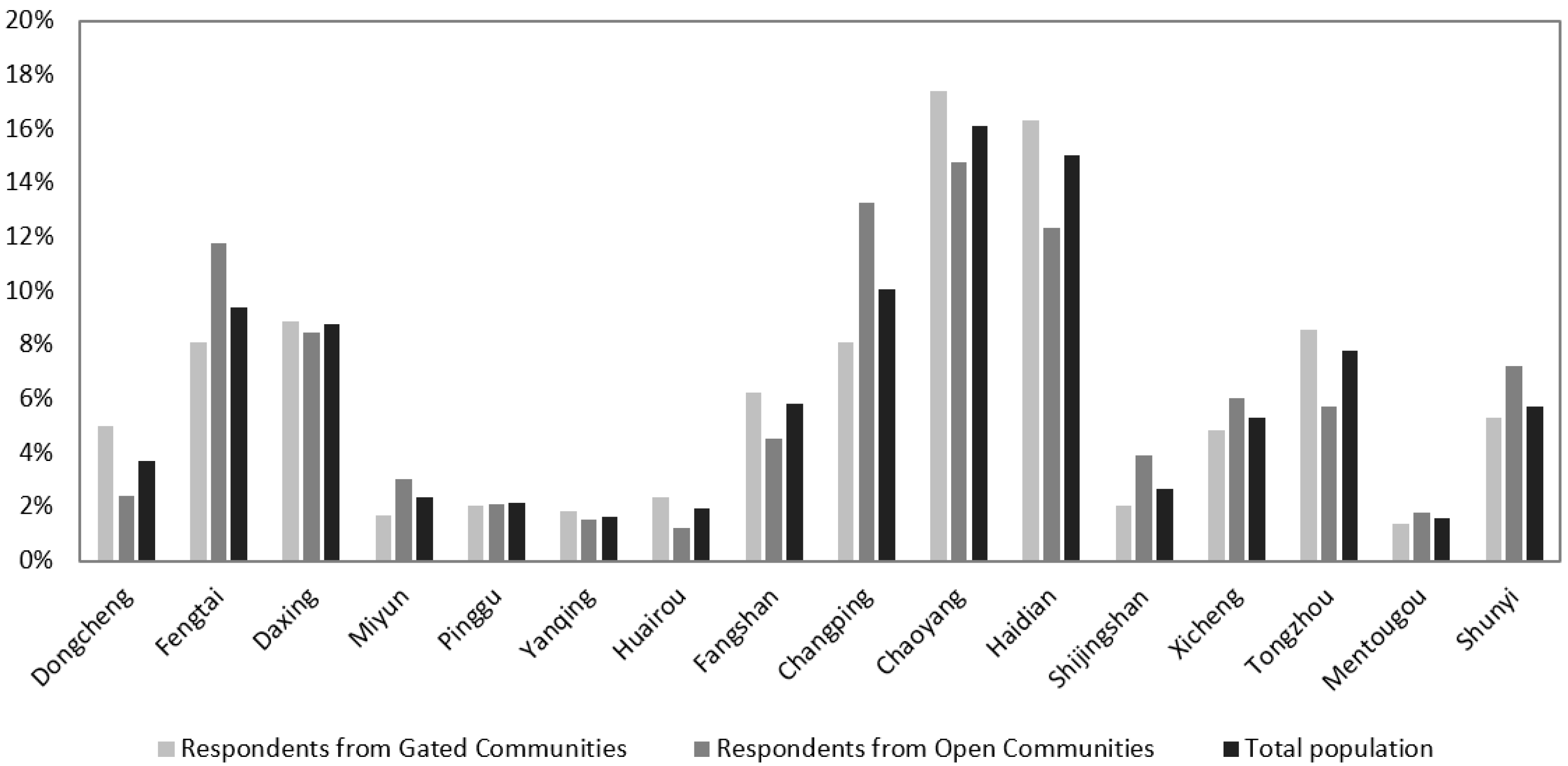
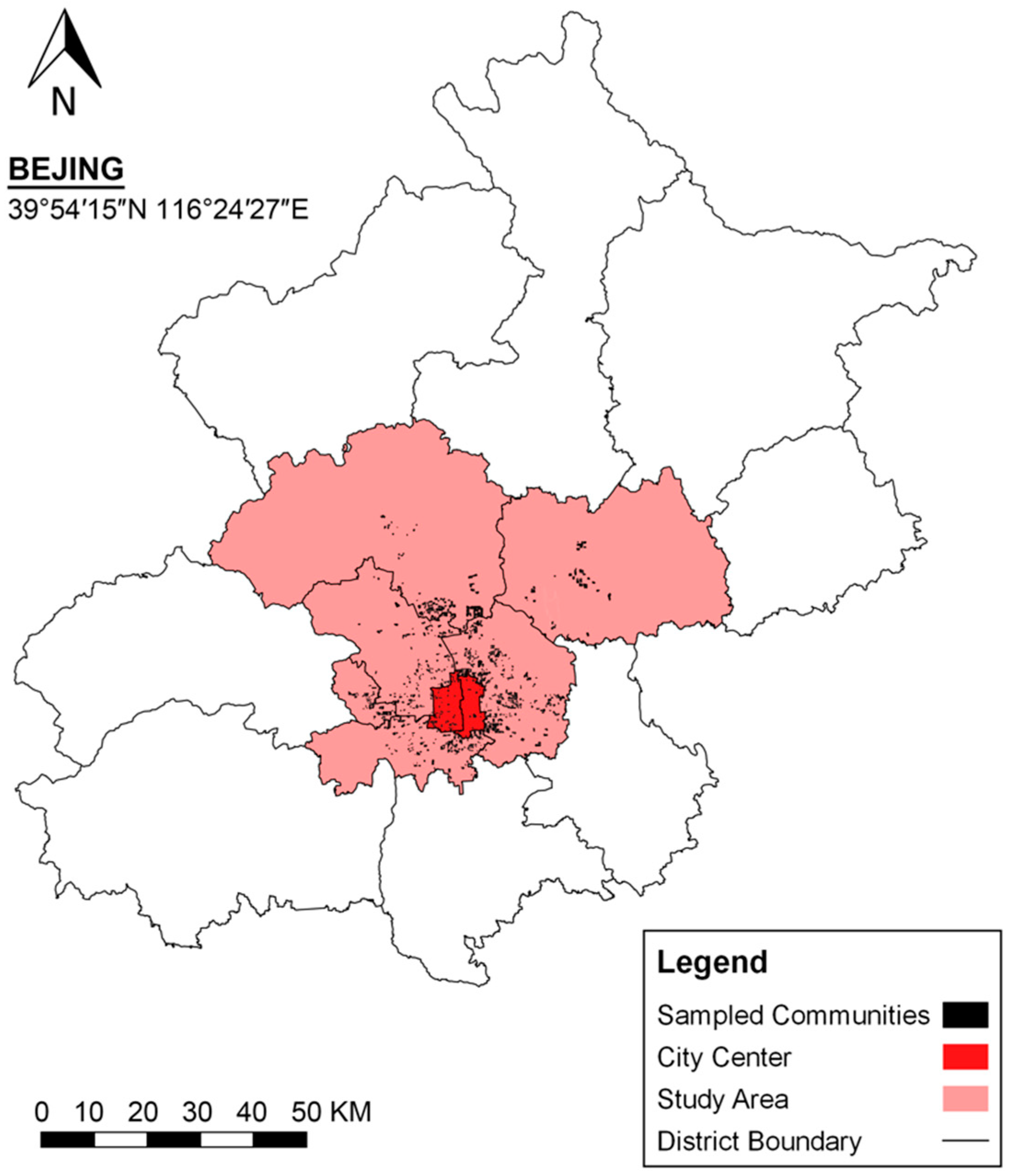

| (1) | (2) | (3) | (4) | |
|---|---|---|---|---|
| All Respondents N = 975 | Respondents from GCs N = 643 | Respondents from Open Communities N = 333 | 2015 Beijing 1% Population Survey N = 234,998 | |
| Female | 33.43% | 34.06 | 32.23% | 47.77% |
| Age: 18–30 | 28.94% | 25.51 | 36.45% | 29.57% |
| Age: 31–40 | 37.33% | 37.01% | 37.35% | 22.39% |
| Age: 41–60 | 25.35% | 28.15% | 20.18% | 32.39% |
| Age: >61 | 8.383% | 9.33% | 6.02% | 15.65% |
| Education: high school and below | 8.483% | 7.93% | 8.73% | 44.09% |
| Education: college degree | 71.36% | 71.07% | 71.99% | 47.09% |
| Education: postgraduate | 20.16% | 21.00% | 19.28% | 8.38% |
| Income: <RMB 5000 | 7.685% | 7.15% | 7.53% | / |
| Income: RMB 5000–10,000 | 36.43% | 36.70% | 34.64% | / |
| Income: RMB 10,000–20,000 | 38.32% | 38.41% | 39.76% | / |
| Income: >RMB 20,000 | 3.994% | 17.73% | 18.07% | / |
| Local Beijing resident | 55.00% | 58.63% | 48.19% | / |
| Rent | 45.11% | 41.06% | 51.81% | 37.41% |
| (1) | (2) | (3) | (4) | (5) | (6) | |
|---|---|---|---|---|---|---|
| N | Mean | S.D. | Min | Median | Max | |
| Price | 76,465 | 4.978 | 2.478 | 0.020 | 4.365 | 43.005 |
| log (Price) | 76,465 | 6.116 | 0.420 | 0.693 | 6.079 | 8.366 |
| Gated | 75,312 | 0.363 | 0.481 | 0 | 0 | 1 |
| Gated Robust | 75,312 | 0.627 | 0.484 | 0 | 1 | 1 |
| Gated Degree | 75,312 | 1.890 | 0.791 | 1 | 2 | 3 |
| Estate Area | 76,465 | 109.458 | 85.474 | 4.420 | 84.669 | 508.280 |
| log (Estate Area) | 76,465 | 11.333 | 0.759 | 8.394 | 11.347 | 13.139 |
| Visited Applicants | 75,540 | 31.594 | 41.029 | 0 | 18 | 927 |
| Discount from Listing Price | 73,385 | 0.034 | 0.025 | 0 | 0.029 | 0.134 |
| High Green Ratio | 76,465 | 0.259 | 0.438 | 0 | 0 | 1 |
| High Plot Ratio | 76,465 | 0.194 | 0.396 | 0 | 0 | 1 |
| With Lift | 76,465 | 0.637 | 0.481 | 0 | 1 | 1 |
| Post COVID 1 | 76,465 | 0.187 | 0.390 | 0 | 0 | 1 |
| Post COVID 2 | 76,465 | 0.062 | 0.242 | 0 | 0 | 1 |
| Gross Floor Area | 76,465 | 81.057 | 34.093 | 15.530 | 72.500 | 652.700 |
| No. of Bedrooms | 76,465 | 2.011 | 0.745 | 0 | 2 | 8 |
| No. of Living Rooms | 76,465 | 1.089 | 0.426 | 0 | 1 | 4 |
| No. of Toilets | 76,465 | 1.175 | 0.411 | 0 | 1 | 5 |
| Floor | 76,465 | 4.023 | 1.077 | 1 | 4 | 6 |
| South Orientation | 76,465 | 0.242 | 0.428 | 0 | 0 | 1 |
| Building Age | 76,465 | 19.660 | 8.851 | 1 | 18 | 70 |
| Subway Within 1 km | 76,465 | 0.547 | 0.498 | 0 | 1 | 1 |
| Bus Within 500 m | 76,465 | 0.495 | 0.500 | 0 | 0 | 1 |
| Mall Within 1 km | 76,465 | 0.527 | 0.499 | 0 | 1 | 1 |
| Park Within 1 km | 76,465 | 0.653 | 0.476 | 0 | 1 | 1 |
| No. of Hospitals in 2 km | 76,465 | 7.550 | 2.155 | 0 | 8 | 10 |
| No. of Kindergartens in 2 km | 76,465 | 4.863 | 0.724 | 0 | 5 | 5 |
| No. of High Schools in 2 km | 76,465 | 4.088 | 1.544 | 0 | 5 | 5 |
| No. of Primary Schools in 2 km | 76,465 | 4.351 | 1.268 | 0 | 5 | 5 |
| Interior Decoration Quality | 76,465 | 2.752 | 1.355 | 1 | 3 | 4 |
| Holding Period | 76,465 | 1.549 | 0.770 | 1 | 1 | 3 |
| Number of Units in Estate | 76,465 | 2944 | 2072 | 220 | 2319 | 13,077 |
| Total Floors in the Building | 76,465 | 14.639 | 8.315 | 0 | 14 | 36 |
| (1) Respondents from GCs | (2) Respondents from Open Communities | |
|---|---|---|
| The willingness to pay a premium for GCs | ||
| The preference for GCS due to: | ||
| The effectiveness of epidemic control | 0.20 *** | 0.26 *** |
| Mitigating the fear for the pandemic | 0.18 *** | 0.17 *** |
| (1) | (2) | (3) | |
|---|---|---|---|
| Log (Price) | |||
| Gated × Post COVID 1 | −0.0031 | ||
| (0.0037) | |||
| Gated × Post COVID 2 | 0.0199 *** | ||
| (0.0059) | |||
| Gated | 0.0372 *** | ||
| (0.0018) | |||
| Gated Robust × Post COVID 1 | −0.0006 | ||
| (0.0034) | |||
| Gated Robust × Post COVID 2 | 0.0186 *** | ||
| (0.0057) | |||
| Gated Robust | 0.0667 *** | ||
| (0.0017) | |||
| Gated Degree × Post COVID 1 | 0.0009 | ||
| (0.0021) | |||
| Gated Degree × Post COVID 2 | 0.0056 * | ||
| (0.0034) | |||
| Gated Degree | 0.0307 *** | ||
| (0.0010) | |||
| Constant | 4.6444 *** | 4.5932 *** | 4.6357 *** |
| (0.0313) | (0.0310) | (0.0309) | |
| Physical Property Features | Y | Y | Y |
| District Fixed Effects | Y | Y | Y |
| Year × Month Fixed Effects | Y | Y | Y |
| Observations | 75,312 | 75,312 | 75,312 |
| R-squared | 0.809 | 0.812 | 0.810 |
| (1) | (2) | (3) | (4) | (5) | (6) | |
|---|---|---|---|---|---|---|
| Number of Visited Applicants | Discounts from Listing Price | |||||
| Gated × Post COVID 1 | 2.2515 *** | −0.0016 *** | ||||
| (0.8728) | (0.0004) | |||||
| Gated × Post COVID 2 | 4.2466 *** | −0.0025 *** | ||||
| (1.5716) | (0.0006) | |||||
| Gated | 1.1114 *** | 0.0009 *** | ||||
| (0.3785) | (0.0003) | |||||
| Gated Robust × Post COVID 1 | 2.0981 *** | −0.0016 *** | ||||
| (0.7990) | (0.0004) | |||||
| Gated Robust × Post COVID 2 | 4.9158 *** | −0.0026 *** | ||||
| (1.3902) | (0.0006) | |||||
| Gated Robust | 0.6477 * | 0.0012 *** | ||||
| (0.3590) | (0.0002) | |||||
| Gated Degree × Post COVID 1 | 0.7439 | −0.0006 ** | ||||
| (0.4745) | (0.0002) | |||||
| Gated Degree × Post COVID 2 | 2.0415 ** | −0.0010 *** | ||||
| (0.8406) | (0.0004) | |||||
| Gated Degree | 0.0470 | 0.0005 *** | ||||
| (0.2054) | (0.0001) | |||||
| Constant | 4.6444 *** | 4.5932 *** | 4.6357 *** | 0.0457 *** | 0.0453 *** | 0.0458 *** |
| (0.0313) | (0.0310) | (0.0309) | (0.0026) | (0.0026) | (0.0026) | |
| Physical Property Features | Y | Y | Y | Y | Y | Y |
| District Fixed Effects | Y | Y | Y | Y | Y | Y |
| Year × Month Fixed Effects | Y | Y | Y | Y | Y | Y |
| Observations | 74,404 | 74,404 | 74,404 | 72,299 | 72,299 | 72,299 |
| R-squared | 0.086 | 0.086 | 0.086 | 0.102 | 0.102 | 0.102 |
Publisher’s Note: MDPI stays neutral with regard to jurisdictional claims in published maps and institutional affiliations. |
© 2021 by the authors. Licensee MDPI, Basel, Switzerland. This article is an open access article distributed under the terms and conditions of the Creative Commons Attribution (CC BY) license (https://creativecommons.org/licenses/by/4.0/).
Share and Cite
Li, L.; Wan, W.X.; He, S. The Heightened ‘Security Zone’ Function of Gated Communities during the COVID-19 Pandemic and the Changing Housing Market Dynamic: Evidence from Beijing, China. Land 2021, 10, 983. https://doi.org/10.3390/land10090983
Li L, Wan WX, He S. The Heightened ‘Security Zone’ Function of Gated Communities during the COVID-19 Pandemic and the Changing Housing Market Dynamic: Evidence from Beijing, China. Land. 2021; 10(9):983. https://doi.org/10.3390/land10090983
Chicago/Turabian StyleLi, Ling, Wayne Xinwei Wan, and Shenjing He. 2021. "The Heightened ‘Security Zone’ Function of Gated Communities during the COVID-19 Pandemic and the Changing Housing Market Dynamic: Evidence from Beijing, China" Land 10, no. 9: 983. https://doi.org/10.3390/land10090983






